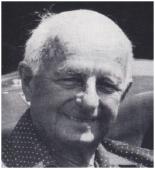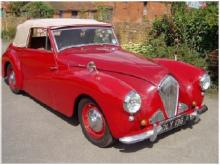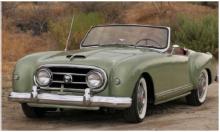
| |

Donald Mitchell Healey
|
DID – U – KNOW
by Facia Nearside
 Born in 1898 he accepted an apprenticeship with Sopwith in 1914. In 1916 he became a pilot in the Royal Flying Corps (RFC). Shot down by friendly fire he was invalided out of the RFC and spent the remainder of the war checking aircraft components for the Air Ministry. In 1920 he opened a garage and hire business but soon found he preferred preparing cars for competition. First entering the Monte Carlo Rally driving a Triumph in 1927 he finally won that event driving an Invicta in 1935. Working for Triumph as experimental manager in 1936 he created the Dolomite which he again drove in the Monte Carlo Rally. Unfortunately, it was written off after a collision with a train in Denmark. In 1939 Triumph went into liquidation and he again went to work for the Air Ministry making carburetters for aircraft engines during WWII. Born in 1898 he accepted an apprenticeship with Sopwith in 1914. In 1916 he became a pilot in the Royal Flying Corps (RFC). Shot down by friendly fire he was invalided out of the RFC and spent the remainder of the war checking aircraft components for the Air Ministry. In 1920 he opened a garage and hire business but soon found he preferred preparing cars for competition. First entering the Monte Carlo Rally driving a Triumph in 1927 he finally won that event driving an Invicta in 1935. Working for Triumph as experimental manager in 1936 he created the Dolomite which he again drove in the Monte Carlo Rally. Unfortunately, it was written off after a collision with a train in Denmark. In 1939 Triumph went into liquidation and he again went to work for the Air Ministry making carburetters for aircraft engines during WWII.
 Engineer, pilot, rally driver, entrepreneur, Donald Mitchell Healey achieved all these things. For most men approaching fifty years of age this would have been a lifetime of accomplishments, but Donald Healey was not most men. During the war there had been many long hours to think of that next step, a marque bearing his own name. What followed was a prolific offering of low volume designs where Healey built the rolling chassis which was then completed by a coach builder, thus giving the car its name. Engineer, pilot, rally driver, entrepreneur, Donald Mitchell Healey achieved all these things. For most men approaching fifty years of age this would have been a lifetime of accomplishments, but Donald Healey was not most men. During the war there had been many long hours to think of that next step, a marque bearing his own name. What followed was a prolific offering of low volume designs where Healey built the rolling chassis which was then completed by a coach builder, thus giving the car its name.
 First came the Healey Elliot saloon in 1946 along with an open version called the Westland Roadster. Powered by a 2.4 litre Riley engine developing well over 100 hp., the Elliot was the world’s fastest four door production car clocking in at 110 mph. This amazing speed turned the Elliot into a popular rally car. First came the Healey Elliot saloon in 1946 along with an open version called the Westland Roadster. Powered by a 2.4 litre Riley engine developing well over 100 hp., the Elliot was the world’s fastest four door production car clocking in at 110 mph. This amazing speed turned the Elliot into a popular rally car.

Healey Silverstone

Healey Abbott

Nash Healey
|
|
 Next was the Healey Sportsmobile in 1948. Styled along the lines of a contemporary American convertible of the period it had the smallest production run of these low volume designs, with just 23 being built. It also had 100 mph performance, so it became popular among rally drivers as well. Naturally, Goldie Gardner was one of the first customers! In 1949 the Healey Silverstone debuted. Named for the Silverstone circuit racetrack it was a two-seat race car thinly disguised for road use. As such it proved popular in club racing and over 100 were produced during a two-year production run. The Elliot and Westland which had been in production since 1946 were then updated as the Healey Tickford and Healey Abbott. These slightly improved designs of the two earlier cars used the same Riley 2.4 litre engine but clothed by two new coach builders respectively. Combined construction totaled a respectable 299 units. Next was the Healey Sportsmobile in 1948. Styled along the lines of a contemporary American convertible of the period it had the smallest production run of these low volume designs, with just 23 being built. It also had 100 mph performance, so it became popular among rally drivers as well. Naturally, Goldie Gardner was one of the first customers! In 1949 the Healey Silverstone debuted. Named for the Silverstone circuit racetrack it was a two-seat race car thinly disguised for road use. As such it proved popular in club racing and over 100 were produced during a two-year production run. The Elliot and Westland which had been in production since 1946 were then updated as the Healey Tickford and Healey Abbott. These slightly improved designs of the two earlier cars used the same Riley 2.4 litre engine but clothed by two new coach builders respectively. Combined construction totaled a respectable 299 units.
 Next in line was the most unlikely and also the most successful of the group, the Nash-Healey. Built from 1950-1954 the car was the outcome of a chance meeting aboard the RMS Queen Elizabeth. Donald Healey was sailing to America in hopes of securing a supply of Cadillac V8 engines for his Healey Silverstone. Aboard he chanced to meet George Mason, the president of Nash-Kelvinator. Upon hearing Healey’s plan Mason invited Healey to contact him when the request for engines was turned down. The result was the Nash-Healey which made its official debut at the 1951 Chicago Auto Show. As a “halo car” one objective was to make the sports car closely resemble other Nash’s models. The car used the Nash inline six-cylinder OHV 3.8 litre engine, and the family resemblance was unmistakable. A total of 506 cars were built, with the first car being personally gifted to British singer Petula Clark by Donald Healey. Next in line was the most unlikely and also the most successful of the group, the Nash-Healey. Built from 1950-1954 the car was the outcome of a chance meeting aboard the RMS Queen Elizabeth. Donald Healey was sailing to America in hopes of securing a supply of Cadillac V8 engines for his Healey Silverstone. Aboard he chanced to meet George Mason, the president of Nash-Kelvinator. Upon hearing Healey’s plan Mason invited Healey to contact him when the request for engines was turned down. The result was the Nash-Healey which made its official debut at the 1951 Chicago Auto Show. As a “halo car” one objective was to make the sports car closely resemble other Nash’s models. The car used the Nash inline six-cylinder OHV 3.8 litre engine, and the family resemblance was unmistakable. A total of 506 cars were built, with the first car being personally gifted to British singer Petula Clark by Donald Healey.
 The final entry into the Healey low volume designs was the Healey G-Type roadster. Built from 1951-1953 this was a hybridized Nash-Healey with a 3 litre Alvis engine and gearbox. The car was quite heavy and underpowered, thus only 25 were produced. With this successful run of eight models totaling 1122 cars over nine years Donald Healey then made perhaps the most astute observation of his career, there were virtually no sports cars in the United States. He immediately set his sights on filling this gap in the American market. The final entry into the Healey low volume designs was the Healey G-Type roadster. Built from 1951-1953 this was a hybridized Nash-Healey with a 3 litre Alvis engine and gearbox. The car was quite heavy and underpowered, thus only 25 were produced. With this successful run of eight models totaling 1122 cars over nine years Donald Healey then made perhaps the most astute observation of his career, there were virtually no sports cars in the United States. He immediately set his sights on filling this gap in the American market.
To be continued…
Editor Note: Article previously published in British Boots and Bonnets newsletter, February2023
|